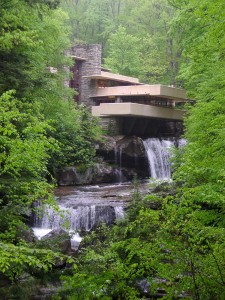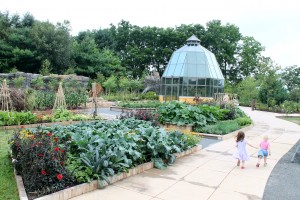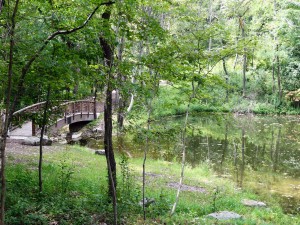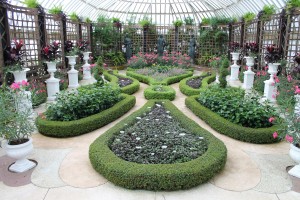Pennsylvania’s Two Newest Gardens
September 8th, 2015
Did you know that Pittsburgh now has a botanic garden?
Have you seen Penn State’s new 1-acre children’s garden?
Lowee’s Group Tours and I will show you both of those – and then some – on a 3-day, 2-night gardener’s mini-vacation coming up Oct. 15-17.
Hardly anyone around here knows about or has seen the Pittsburgh Botanic Garden, the nation’s first public garden built on reclaimed mine land. The first 60 acres of it just opened last fall.
Located 20 minutes southwest of Pittsburgh in a county park, this place is going to eventually cover 460 acres.
For now, it has five different woodland gardens, a lotus pond in what used to be a dead pond with the water quality of battery acid, an heirloom apple orchard, a meadow, a wedding garden and 3 acres of trails.
On the drawing board is the Fred Rogers Garden of Make Believe, which is going to be a “family garden” (as opposed to a children’s garden) drawing inspiration from the long-running PBS “Mister Rogers’ Neighborhood” show.
At Pittsburgh Botanical Garden, we’ll get a guided tour and have time to enjoy the serenity of what until recently was a weed jungle grown over top of a mine waste land.
But before we get to Pittsburgh, we’ll spend most of the first day enjoying the Penn State Arboretum, itself a very young garden that surprisingly few midstaters have seen.
We’ll have time to stroll the arboretum’s flower gardens, rose garden, tropical pots, water features and collection of trees and shrubs, but we’re going to focus especially on the new Childhood’s Gate Children’s Garden.
That one also just opened last year and is different from any children’s garden you’ve probably seen.
Kim Steiner, the arboretum’s director, tells people this is not intended as a playground but as a slice of Pennsylvania that will entice kids to explore and appreciate the natural world around them.
It’s way more than sunflowers and bean teepees. It’s a “learning landscape” that features a cave with stalactites and a secret sandbox; a 20-foot-tall, bell-shaped glasshouse for hands-on projects; a giant, concrete spicebush swallowtail caterpillar to climb on with real spicebush plants behind; a replica of a Pennsylvania meadow with a Susquehannock native-American encampment next to it, and a series of raised-bed vegetable gardens.
After seeing all of that, we’ll head over to the Penn State Berkey Creamery for an ice-cream cone (obligatory on any trip to University Park) and have a box lunch on the way to the National Aviary in Pittsburgh.
Pittsburgh’s National Aviary is America’s only independent indoor nonprofit zoo dedicated exclusively to birds and is the nation’s biggest aviary.
Located in Pittsburgh’s North Side, it has more than 500 birds of more 150 species from around the world, many of them threatened or endangered.
We’ll walk through the free-flying exhibits, check out the rose garden out back, and spend some time watching my favorite part – the African penguins.
Dinner is included at our hotel for two nights, the Doubletree by Hilton right in the heart of downtown.
Day 2 starts with a visit most of the morning to the Pittsburgh Botanic Garden. Then we’ll head over to Station Square for a bite to eat and some free time to shop or gawk before boarding the Gateway Clipper ship for a sightseeing cruise on the city’s three rivers.
Then we’ll take a ride up the Duquesne Incline – one of only two such inclines left in the city – and see Pittsburgh’s Golden Triangle from above. USA Today once named that view as one of the world’s top 10 best views of a cityscape.
After dinner at the Lemont Restaurant atop Mt. Washington, we’ll bus over to Phipps Conservatory and Botanical Gardens for a twilight visit to this gorgeous Victorian-era glasshouse.
Until the Pittsburgh Botanic Garden came along, Phipps was the only public-garden presence west of Penn State. Located in the city’s Schenley Park, this tropical-plant-filled conservatory dates to 1893 and was a gift to Pittsburgh and its people by steel and real-estate magnate Henry Phipps.
If you’ve never seen it, Phipps Conservatory is made up of 13 different indoor rooms (including excellent palm and orchid collections as well as a tropical butterfly room), plus several outdoor gardens. My favorite part there is the Broderie Room, a French-style display garden that changes looks with the seasons.
Phipps also is one of the most environmentally friendly buildings in the U.S., and its entire café has a garden for a roof.
After a night’s snooze back at the Doubletree, we’ll start Day 3 enjoying the fall festivities at the Pittsburgh area’s largest garden center – Trax Farms.
This sixth-generation family-owned operation south of Pittsburgh is a 550-acre farm with 12 acres devoted to a retail garden center, nursery, produce market, bakery and deli. It’s huge, and they go all out for fall – so much so that this is one garden center that has its biggest month in October.

Frank Lloyd Wright designed Fallingwater to be built directly over the top of a waterfalls on Bear Run.
After spending the morning there, it’s off to Frank Lloyd Wright’s Fallingwater house in the Laurel Highlands of Fayette County.
This iconic, cantilevered house built over top of a waterfall has been called Wright’s “most beautiful job” and was named as the best all-time work of American architecture by the American Institute of Architects.
We’ll tour this unique house but also have time to explore the naturalistic landscape around it. And then head home with some great pictures and memories.
The trip cost is $525 per person double, including the hotel, transportation, all admissions, the river cruise, six meals and lots of prizes, including $25 gift cards to Stauffers of Kissel Hill, which sponsors most of the garden trips Lowee’s and I do.
If you’re interested, call Lowee’s at 717-657-9658 to book or email CKelly@lowees.com.
Pickups are on both East and West shores.
Lowee’s also has the full itinerary and a signup sheet on its website.










